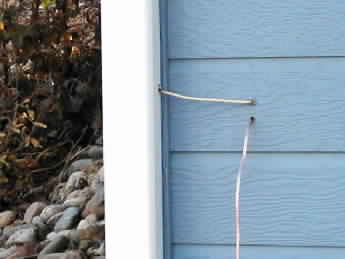|
|
|
 |
 |
 |
| By Jack Ciaccia, WM�G |
|
| This is the third, and latest version of the all band Rain Gutter Antenna used at my new QTH. These antennas can get really expensive when you move every few years.. HI! |
| We moved into a new house in a golf country club community and of course, it has HOA CCR restrictions regarding ham radio antennas, just like the other developments we have lived in here near Boulder, Colorado. |
| But, this time I have a home with a nice tall raingutter on the SE corner of the house. The home is built into a hillside and the rear of the house has raingutters that are over 25' tall. |
| The radio shack is located in the basement and I was able to drill a couple of discrete holes through the wall to get the lead-in antenna and ground wires to the venerable SGC-230 antenna coupler. |
| I laid out a series of radial wires extending about 60' each radiating from the corner of the house, as I had in my previous installations. I am still using the same transceiver, an old Icom IC-745 running about 80 watts. |
| Signal reports are similar to what I had been getting at the other QTH. I can work any DX that I can hear, and I am able to work on the WAS nets as I had before, with approximately the same signal reports (plus or minus propagation and conditions). As you all probably know from your own experience this past year, conditions have been generally poor (OK... lousy) for DXing. |
| I managed to work the 160 meter contest this past December (2003) and logged 80 QSO's from the east to west coast as well as three DX countries in the Caribbean in just 5 straight hours of operating time. Not a great contest 'run rate' by any means, but at least I was participating. Again, I'm sure most of the work is being done by the other station's antenna BUT.. You still have to put out some sort of signal on that band to be heard. |
| On 80 meters I still work the GERATOL WAS net from time to time and although I didn't spend much time there this season, I did manage to work all states (again) in a couple of months of casual operating. |
| On 40 meters the antenna works great. I can work any of the DX that I hear and reports are consistently very decent (from S7 to S9). |
| On 30 meters, where all stations are created equal (power wise, at least), I can usually break a pile up for the rare DX station. Signal reports from 559 to 599 are typical, with most DX reporting 579. Of course, these reports are also tempered by the conditions at the time. |
| On 20 meters the raingutter performs very well and I am able to again work anything I can hear. Competition on this band is keen and if there is a pile up, I usually am down in the 'pecking order' a bit, but I still get them. |
| On 17 meters I have has a lot of QSO's with stations that find it unbelievable that I am using a raingutter for my antenna. Once I start a QSO on the subject, I usually get two, three and sometimes, four QSO's in succession with all sorts of questions and compliments on my signal. The raingutter antenna subject is definitely a good QSO topic for discussion. |
| On 15, 12 and 10 meters the antenna works well again. I don't spend too much time on those bands as most of my operating is done during the evening hours. The few times I have been on those bands though, the antenna worked well and I was getting consistently good reports. |
| The only interference I have noticed is with my fax machine in my home office. The RFI played havoc with it at first, but a couple of well placed RF chokes on the line cord and telephone line cured that fairly easily. I haven't noticed any other interference nor have I received any complaints from my new neighbors. Of course, they don't even know I have a ham radio station as there aren't any tell-tale signs outside! I am operating a stealthy, yet effective, amateur radio station and everybody is happy.. Including the "CCR Nazi's" that run the local HOA and enforce the dreaded covenants. |
| I recently was asked by the SGC folks if they could reprint the previous articles I had written on my raingutter antenna. I was only too pleased to have them include my articles in their newsletter and it has since inspired a few hams around the world, who face similar restrictions, to use their rain gutters as antennas too. |
| I'm not sure if this will be my last rain gutter antenna, as the XYL and myself have been discussing 'downsizing' to a smaller home as we get nearer to retirement age. So, I will probably be shopping for a new raingutter antenna (and a home to install it on too) in the coming months. Now that I am sure that I can duplicate my raingutter antenna system performance from the previous versions, I will be less apprehensive about a new QTH. Of course, I could go out and spoil all of this fun by building in a non-CCR subdivision and put up a tower, beam and verticals like other hams do, but what's the challenge in doing that? |
 |


